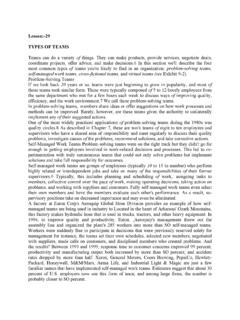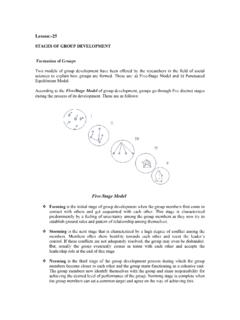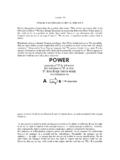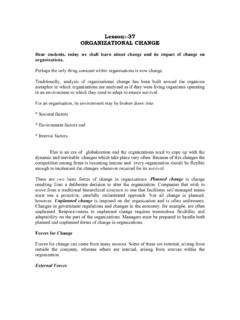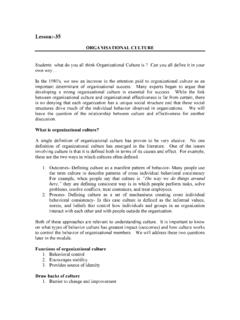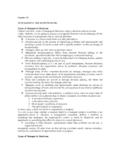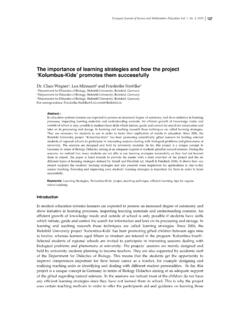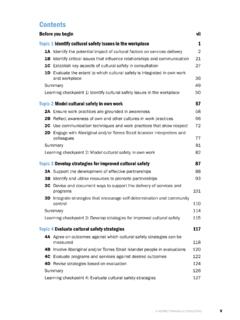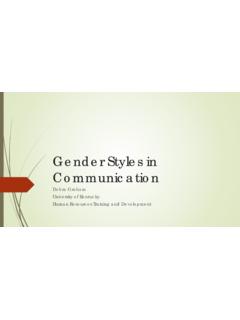Transcription of Behavioural Reactions to Change
1 Lesson:-38 Behavioural Resistance to Change Students today we shall learn about behavioral Reaction to Change . How employees perceive a Change greatly affects how they react to it. A. If employees cannot foresee how the Change will affect them, they will resist the Change or be neutral, at best. B. If employees clearly see that the Change is not compatible with their needs and aspirations, they will resist the Change . C. If employees see that the Change is going to take place regardless of their objections, they may initially resist the Change and then resignedly accept it. D.. If employees see that the Change is in their best interests, they will be motivated to accept it. In spite of attempts to minimize the resistance to Change in an organisation, some Reactions to Change are inevitable.
2 Negative Reactions may be manifested in overt behaviour, or Change may be resisted more passively. People show four basic, identifiable Reactions to Change : disengagement, disidentification, disenchantment, and disorientation. Managers can use interventions to deal with these Reactions as shown in Table Disengagement is psychological withdrawal from Change . The employee may appear to lose initiative and interest in the job. Employees who disengage may fear the Change but take on the approach of doing nothing and simply hoping for the best. Disengaged employees are physically present but mentally absent. They lack drive and commitment, and they simply comply without real psychological investment in their work. Disengagement can be recognized by behaviours such as being hard to find or doing only the basics to get the job done.
3 Typical disengagement statements include No problem or This won t affect me. The basic managerial strategy for dealing with disengaged individuals is to confront them with their reaction and draw them out so that they can identify the concerns that need to be addressed. Disengaged employees may not be aware of the Change in their behaviour, and they need to be assured of your intentions. Drawing them out and helping them air their feelings can lead to productive discussions. Disengaged people seldom become cheerleaders for the Change , but they can be brought closer to accepting and working with a Change by open communication with an emphatic manager who is willing to listen. Another reaction to Change is disidentification. Individuals reacting in this way feel that their identity has been threatened by the Change , and they feel very vulnerable.
4 Many times they cling to a past procedure because they had a sense of mastery over it, and it gave them a sense of security. My job is completely changed and I used to .. are verbal indications of disidentification. Become involved in the Change and establish a feeling of ownership in the process. When employees are allowed to participate, they are more committed to the Change . Another strategy for managing resistance is providing empathy and support to employees who have trouble dealing with the Change . Active listening, as was discussed in Chapter8, is an excellent tool for identifying the reasons behind resistance and for uncovering fears. An expression of concerns about the Change can provide important feedback that managers can use to improve the Change process.
5 Emotional support and encouragement can help an employee deal with the anxiety that is a natural response to Change . Employees who experience severe Reactions to Change can benefit from talking with a counselor. Some companies provide counseling through their employee assistance plans. Open communication, participation, and emotional support can go a long way toward managing resistance to Change . Managers must realize that some resistance is inevitable, however, and should plan ways to deal with resistance early in the Change process. Managing resistance to Change is a long and often arduous process. GTE Mobilnet faced substantial resistance to Change when it implemented its customer connection initiative, with the goal of building a cellular phone network that ranks first in customer service.
6 The Change agent, Ben Powel, and his teammates tried to persuade staffers at Mobilnet s 350 service centers to send new cellular phones out the door with fully charged batteries in them. The salespeople liked the idea they could tell customers that their phones were ready to use when they sold them. Service workers, however, balked at the idea because they were the ones who had to install the batteries. Powell and his team essentially repeated the following dialogue 350 times: You cant see why you need to bother with installing the batteries? Here are sales figures showing how much revenue we lose by making customers wait to use their phones. The average customer calls everybody he knows when he first gets the thing, like a kid with a new toy but only if it has a charged battery in it.
7 Don t have roo to stock all those batteries? We ll help you redesign your identified employees often display sadness and worry. They may appear to be sulking and dwelling on the past by reminiscing about the old ways of doing things. Because disidentified employees are so vulnerable, they often feel like victims in the Change process. Managers can help them through the transition by encouraging them to explore their feelings and helping them transfer their positive feelings into the new situation. One way to do this is to help them identify what it is they liked in the old situation, as well as to show them how it is possible to have the same positive experience in the new situation. Disidentified employees need to see that work itself and emotion are separable that is, that they can let go of old ways and experience positive Reactions to new ways of performing their jobs.
8 Disenchantment is also a common reaction to Change . It is usually expressed as negativity or anger. Disenchanted employees realize that the past is gone, and they are mad about it. They may try to enlist the support of other employees by forming coalitions. Destructive behaviours like sabotage and backstabbing may result. Typical verbal signs of disenchantment are This will never work and I m getting out of this company as soon as I can. The anger of a disenchanted person may be directly expressed in organisational cultures where it is permissible to do so. This behaviour tends to get the issues out in the open. More often, however, cultures view the expression of emotion at work as improper and like unbusiness. In these cultures, the anger is suppressed and emerges in more passive aggressive ways, such as badmouthing and starting rumors.
9 One of the particular dangers of enchantment is that it is quite contagious in the workplace. It is often difficult to reason with disenchanted employees. Thus, the first step in managing this reaction is to bring these employees from their highly negative, emotionally charged state to a more neutral state. To neutralise the reaction does not mean to dismiss it; rather, it means to allow the individuals to let off the necessary steam so that they can come to terms with their anger. The second part of the strategy for dealing with disenchanted employees is to acknowledge that their anger is normal and that you do not hold it against them. Sometimes disenchantment is a mask for one of the other three Reactions , and it must be worked through to get to the core of the employee s reaction.
10 Employees may become cynical about Change . They may lose faith in the leaders of Change . The Scientific Foundation presents a study that explored the reasons employees become cynical. A final reaction to Change is disorientation. Disoriented employees are lost and confused, and often they are unsure of their feelings. They waste energy trying to figure out what to do instead of how to do things. Disoriented individuals ask a lot of questions and become very detail oriented. They may appear to need a good deal of guidance and may leave their work undone until all of their questions have been answered. Analysis paralysis is characteristic of disoriented employees. They feel that they have lost touch with the priorities of the company, and they may want to analyze the Change to death before acting on it.
